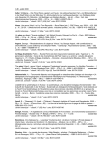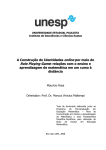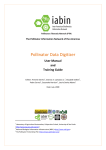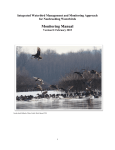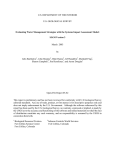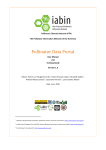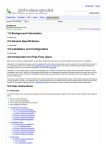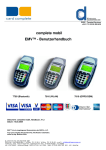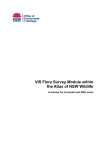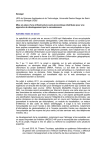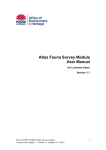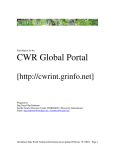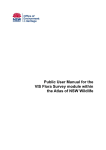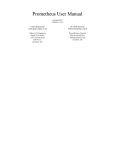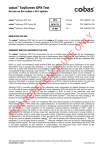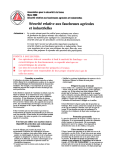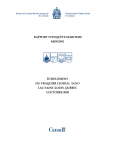Download Chapter 4
Transcript
Chapter 4 Individual records and the associated data: information standards and protocols by Alexander Kroupa European Distributed Institute of Taxonomy (EDIT), Museum für Naturkunde - Leibniz Institute for Research on Evolution and Biodiversity Invalidenstr. 43, 10115 Berlin, Germany Email: alexander.kroupa@mfn-berlin.de David Remsen Global Biodiversity Information Facility (GBIF) Universitetsparken 15, 2100 Copenhagen, Denmark Email: dremsen@gbif.org 49 Abstract The structure of databases with taxonomic content is very important to ensure a compatibility with other database systems. For the exchange of taxonomic information it is necessary to have standards and protocols to permit the presentation, e.g. on a web system like GBIF, of species data from different database sources. For ATBI+M projects a guideline for recording species has been developed with the minimal requirements for a high data quality standard. Also standards are used, errors may occur along the information management chain from data recording up to data presentation. Error sources can be within the geo-referenced domain as well as in the taxonomic domain. Therefore software for automated geo-referencing and recording of date and time in standardized formats for mobile phones with GPS up to water resistant PDAs have to be developed. The gain of using those field tools is improving data quality and simplifying the data recording for a cost effective process to obtain high quality taxonomic information. Key words: taxonomic database, standards, data quality, field tools, ATBI+M 50 1. Introduction Taxonomic databases – databases that store information about biological entities: species and other taxa – have been developed to address curatorial management requirements, taxonomic and scientific needs, and more recently, for presentation of species data (distribution maps, pictures, biology etc.) to a wider public (Dalcin, 2005). These databases have the taxon as the principal entity, represented by its main identification: the taxon name. Taxonomic databases often have a focus on terminal taxa: species and infraspecies levels, which consist of a genus and species name, and when applicable, additional infra-species names. Data or Information is tied to the taxon and typically falls into two levels of organisation: either elements that relate to the taxon as a whole or elements that relate to specific instance of a taxon. The latter class of information is known as species occurrence, or primary occurrence data. Primary occurrence data include data elements that describe a taxon occurrence such as a date a species may have been collected or a location where it was observed. General species data, on the other hand, describe properties ascribe to the entire taxon such as a general morphological description, or a range map. In this chapter we will focus on databases for primary occurrence data. Every day probably more than 100,000 scientific biological records (observations, collected specimens) are recorded (personal estimation). Many of these data are still not digitally recorded and the majority of these data are not recorded using standard protocols or proper referencing. The goal is that all recorded datasets should be properly referenced and that all individual field records must be accurately geo-referenced with an exact date or interval. Therefore more and more electronic tools and software have to be used to facilitate the recording of species data sets and to minimize the amount of errors. This chapter provides a review of the important data structure elements of primary occurrence data with the inclusion of best practices and recommendations in their use. 2. Data structure Species-occurrence data is used to include specimen label data attached to specimens or lots housed in museums and herbaria (or in Universities, NGOs, Amateurs associations etc.), observational data (e.g. birdwatchers) and environmental survey data (Chapman, 2005a). The term has occasionally been used interchangeably with the term “primary species data”. In general we speak about “geo-referenced data” – e.g. records with geographic references that tie them to a particular place in space – whether with a geo-referenced coordinate (e.g. latitude and longitude, UTM) or not (textual description of a locality, altitude, depth). Normally, the data are referred to as “point-based”, although line (transect data from environmental surveys, collections e.g. along a river), polygon (observations from within a defined area such as a national park) and grid data (observations or survey records from a regular grid) are also included. Usually the data are also tied to a taxonomic name, but unidentified collections 51 may also be included by referencing to a higher taxon group (e.g., “Unidentified Aves”). For sampling species data it is necessary to record not only where (a geospatial location) the species were found, but also when (date and time), what (taxonomy), how (collecting method) and who collected/observed the specimen. Each locality (where) may have different events (Fig. 1), which means that sampling at more than one date or with different sampling methods have been carried out. Each event in turn may have its own species list or even more than one list if different researchers built their own lists for the same event. Fig. 1. Context of Locality, Event and Taxonomy by recorded species data. 2.1. Localities – where Good locality descriptions lead to more accurate geo-references with smaller uncertainty values and provide users with much more accurate and high quality data. When recording data in the field, whether from a map or when using a GPS, it is important to record locality information as well as the geo-references, so that later validation can take place if necessary (Chapman & Wieczorek, 2006). One purpose behind a specific locality description is to allow the validation of coordinates, in which errors are otherwise difficult to detect. The extent to which validation can occur depends on how well the locality description and its spatial counterpart describe the same place. The highest quality locality description is one with as few sources of uncertainty as possible. By describing a place in terms of a distance along a path, or by two orthogonal distances from a place, one removes uncertainty due to imprecise headings. Choosing a reference point with small extent reduces the uncertainty due to the size of the reference point, and by choosing a nearby reference point, one reduces the potential for error in measuring the offset distances. 52 To make it easy to validate a locality, use reference points that are easy to find on maps or in gazetteers. At all costs, avoid using vague terms such as “near” and “centre of” or providing only an offset without a distance such as “West of Albuquerque” (Table 1). In any locality that contains a named place that can be confused with another named place of a different type, specify the feature type in parentheses following the feature name. Data without locality information or only with doubtful details should be flagged as not possible to geo-reference them with current information. Vague Localities BAD: Sacramento River Delta - an extremely large geographic area BETTER: Locke, Sacramento River Delta, Sacramento Co., California - names a town within the Delta Highway 9, Alajuela Province, Costa Rica Names of Roads BAD: without additional GOOD: Intersection of Hwy 9 and Rio Cariblanco, Cariblanco points of reference (town), Alajuela Province, Costa Rica Localities difficult to For many countries, especially Spanish-speaking ones, there are Georeference oftentimes several cities with the same name in the same province. BAD: San Marcos, Intibuca Province, Honduras - There are at least five San Marcos in Intibuca Province BETTER: San Marcos, ca 7.5 km south of Los Chaguites, Intibuca Province, Honduras Table 1. Some examples for good and bad locality descriptions (from Museum of Vertebrate Zoology 2009a). Guide for recording localities (Museum of Vertebrate Zoology 2009b) Full Locality Name. Provide a descriptive locality, even if you have geographic coordinates. Write the description from specific to general, including a specific locality, offset(s) from a reference point, and administrative units such as county, state, and country. The locality should be as specific, succinct, unambiguous, complete, and accurate as possible, leaving no room for uncertainty in interpretation. Hint: The most specific localities are those described by a) a distance and heading along a path from a nearby and well-defined intersection, or b) two cardinal offset distances from a single nearby feature of small extent. 53 Altitude (Elevation). Supplement the locality description with elevation information. Hint: A barometric altimeter, when properly calibrated, is much more reliable than a GPS for obtaining accurate elevations. Coordinates. Whenever practical, provide the coordinates of the location where collecting actually occurred (see Radius, below). If reading coordinates from a map, use the same coordinate system as the map. Hint: Decimal degrees coordinates are preferred when reading coordinates from a GPS and if possible provide lat/long data. Geographic Datum. The datum is an essential part of a coordinate description; it provides the frame of the reference. When using both maps and GPS in the field, set the GPS datum to be the same as the map datum so that your GPS coordinates will match those on the map. Hint: Always record the datum with the coordinates. GPS Accuracy. Record the accuracy as reported by the GPS whenever you take coordinates. Hint: Most GPS devices do not record accuracy with the waypoint data, but provide it in the interface showing current satellite conditions. Radius (Extent). The extent is a measure of the size of the area within which collecting or observations occurred for a given locality – the distance from the point described by the locality and coordinates to the furthest point where collecting or observations occurred in that locality. Hint: A 1 km linear trap line for which the coordinates refer to the centre has an extent of 0.5 km. References. Record the sources of all measurements. Minimally, include map name, GPS model, and the source for elevation data. For including geo-referenced records or observations into a database the pointradius method is commonly used (Wieczorek et al., 2004). This method describes a locality as a coordinate pair (important: always include the geographic datum!) and a distance from that point (that is, a circle), the combination of which encompasses the full locality description and its associated uncertainties (GPS accuracy). The key advantage of this method is that the uncertainties can be readily combined into one attribute. With modern GPS devices the uncertainties are usually less than 10 m. To include historical data from natural history collections this method is also useable, when localities have typically been recorded as textual descriptions, without geographic coordinates. The calculation of the radius takes into account aspects of the precision and specificity of the locality description, as well as the map scale, datum, precision and accuracy of the sources used to determine coordinates. 2.2. Events – when Guide for recording events 54 Start Date. The date of the collection or observation should at least be recorded and if available the time as well. Hint: use a date format e.g. DD.MM.YYYY and a time format hh:mm:ss. End Date. For intervals (e.g. traps which are a longer period in the field) it is necessary to have a date for the end of the research. Hint: Use the end date also when the fieldwork takes only a couple of hours. Collector(s). Provide the name of each collector and when relevant the name of the expedition or research vessel (i.e. boat). Hint: Do not use abbreviations, write the full name, including second names or attributes like senior, junior to identify the collectors uniquely and avoid ambiguity of homonyms or families of collectors over several generations. 2.3. Taxonomy – what Names, whether they are scientific binomials or common names, provide the first point of entry to most species and species-occurrence databases. The correct spelling of a scientific name is generally governed by one of the various Codes of Nomenclature (see list under Technical References). Errors can still occur, however, through typing errors, ambiguities in the Nomenclatural Code, etc. The easiest method to ensure such errors are kept to a minimum is to use an ‘Authority File” during recording of data (Chapman, 2004a). An authority file is a pre-composed list of verified species names. Current lists of species names may be found at a number of places and some of these are listed in Chapman (2004b) (e.g. Species2000, FaunaEuropaea, 4D4Life). Also, the re-use of entered terms via internal controlled lists in an application that provides pull-down lists of previously entered terms can help maintain consistency when a controlled list is not available. If it is not possible to use authority lists, a recommendation is than to process the collected information as quickly as possible after the fieldwork. The structure of the database has to be clear, unambiguous and consistent. The taxon information should be atomized so that it is always clear that one field includes just the genus or the species name and is not mixed to have just one field with the genus and the species name together. One should always atomize the taxonomic information into separate Genus/Species/infraspecific Rank/Infraspecies/Author fields etc. wherever possible. Guide for recording the minimum taxonomy for species-level taxa Genus name. The genus name is essential. Hint: Do not use any abbreviation. Species name. The species name is essential. Hint: Do not use any abbreviation. Authors of a species name. The author(s) name should be included to ensure a unique mapping in case of homonyms. Determinator. The name of the person(s) who is responsible for the determination of the collection/observation. Hint: Do not use any abbreviation, write the full name. 55 Taxon Source. A reference to a taxonomic guide or treatment that forms the basis for the identification. Species are often lumped with or split from other taxa over the course of revisions. Ambiguity is reduced by providing a reference to particular taxonomic view that provides a specific sense or definition of the taxon as used by the identifier. Number. The number of the individuals observed or collected. Hint: Use only numbers and no text (not 2-3, 3ff, some, abundant etc.) Deposit. For further studies the deposit of collected material should be recorded. Hint: Abbreviations have to be well-defined, better do without abbreviations. Add the town of the museum, especially if it is not a wellknown museum. Family and other higher parent taxa. The family or higher taxon that includes the referenced species. This information may be useful for providing taxonomic context in later references to the record. 3. Standards Since more and more taxonomic databases are appearing, both institutional and individual concern about sharing data is rising. At this moment the need to establish data standards and communication protocols is obvious in order to make data sharing between different databases possible (Dalcin, 2005). A number of recent collaborations within the museum community have resulted in establishing data standards. Examples include the Darwin Core Schema (Vieglais, 2003) along with the DiGIR protocol (SourceForge, 2004) and the combined BioCASE protocol (BioCASE 2003) and ABCD schema (TDWG, 2004) that are more fitted for interchange of primary species information. The Biodiversity Information Standards (TDWG) and others developed a new protocol (TAPIR - http://ww3.bgbm.org/tapir) that supports multiple data formatting standards that is intended to provide a single solution for publishing data to the GBIF network. TAPIR can be implemented in multiple degrees of complexity and capacity (lite, medium, full) but importantly, still require advanced technical skills to install and maintain. The newest and ratified Darwin Core terms provides a unified approach to publishing both species-level and species-occurrence-level data using a common standard. This "DarwinCore Archive" format is being championed by GBIF and while it is a supported output of the Integrated Publishing Toolkit, provides a simple enough data publication solution that it can be output as a direct database export by many data managers. For recording geo-referenced species data a guideline with the most important fields for species occurrence data has been developed within the EDIT project (EDIT, 2009). This structure has been developed especially for recording data in the ATBI+M sites and is used by everyone sampling for ATBI purposes. It may also be used as a base for creating own databases. 56 4. Errors 4.1. Sources of error in data (Hellerstein, 2008) Data entry errors. It remains common in many settings for data entry to be done by humans, by keying in data from written or printed sources, e.g. after fieldwork. In these settings, data is often corrupted at entry time by typographic errors or misunderstanding of the data source (see 2.3). Measurement errors. In the measurement of physical properties, as altitude or spatial data, the increasing proliferation of sensor technology has led to exact measurements. Nevertheless data errors are still quite common: selection and placement of sensors often affects data quality, and by transferring data to the database errors may occur. Converting coordinates from one system to another may cause errors and converting longitude/latitude data from degrees to decimal may often result in a wrong calculation (Table 2). Distillation errors. In many settings, raw data are preprocessed and summarized before they are entered into a database. This data distillation is done for a variety of reasons and has the potential to produce errors in distilled data, or in the way that the distillation technique interacts with the final analysis. Data integration errors. Any procedure that integrates data from multiple sources can lead to errors. To minimize integration errors standards are necessary to ensure that fields contain the same entity type. That e.g. a species field contains only the species epithet and not genus and epithet together. latitude / longitude formula calculation decimal result 44° 16’ 12,01’’ - 7° 23’ degrees + (minutes / 44 + (16 / 60) + (12,01 / 44,27000278° 7,39680556° 3600) / 7 60) + (seconds / 48,50’’ 3600) + (23 / 60) + (48,50 / 3600) 44° 15,368’ - 7° 22,86’ degrees + (minutes / 44 + (15,368 / 60) / 7 + 44,2728° - 7,381° 60) (22,86 / 60) Table 2. Two examples to show how to convert longitude/latitude data from degrees to decimal. Names form the major key for accessing information in primary species databases. If the name is wrong, then access to the information by users will be difficult, if not impossible. Table 3 shows what may happen when entering names in a non-standard way. This is an extreme example but misspellings of names are the most frequent error in taxonomic databases. 57 Actinobacillus actimomycetemcomitans Actinobacillus actinomycetecomitans Actinobacillus actinomycetum Actinobacillus actimycetemcomitans Actinobacillus actinomycetemcmitans Actinobacillus actinomyctemcomitans Actinobacillus actinmycetemcomitans Actinobacillus actinomycetemcomintans Actinobacillus actinomyectomcomitans Actinobacillus actinomicetemcomitans Actinobacillus actinomycetemcomitance Actinobacillus actinomyetemcomitans Actinobacillus actinomy Actinobacillus actinomycetemcomitans Actinobacillus actinonmycetemcomitans Actinobacillus actinomycetemcomitants Actinobacillus actionomycetemcomitans Actinobacillus actinomycetemcommitans Actinobacillus actynomicetemcomitans Actinobacillus actinomycetemocimitans Actinobacillus antinomycetemcomitans Actinobacillus actinomyce Actinobacillus actinomycemcomitans Actinobacillus actinomyceremcomitans Actinobacillus actinomycetam Actinobacillus actinomycetamcomitans Actinobacillus actinomycetencomitans Table 3. Result of non-standard data entry for the valid species Actinobacillus actimomycetemcomitans (source: from Neil Sarkar, uBio Project). 4.1. Data cleaning Chapman (2005a) shows that the cost of error correction increases as one progresses along the Information Management Chain (Fig. 2) and a manual process of data cleansing is also laborious, time consuming, and itself prone to errors (Maletic & Marcus, 2000). Tools have to be developed for data cleaning and preventing of errors at their point of origin is the most cost-effective method. Tools are being developed to assist the process of adding geo-referencing information to databased collections. Such tools include eGaz (Shattuck, 1997), geoLoc (CRIA, 2004), BioGeomancer (Peabody Museum n.dat.), GEOLocate (Rios and Bart n.dat.) and the Georeferencing Calculator (Wieczorek, 2001). The most important point is that correcting problems and adding sufficient annotation for use should be done prior to, not after, publication of the data. Data validation and annotation services should be done by the curator, not after the data has been published and copies transferred. When services are run against a copy of the data they need to be transferred and reconciled with the source copy, increasing complexity and risking the introduction of new errors. This approach will not apply to the many legacy datasets that are no longer curated so there will always be a need for the application of validation and annotation services as post-publication processes as well. 58 5. New technologies for data recording It is necessary to develop tools for recording spatial and taxonomic data in the field for a number of reasons. In particular it is cost-effective to avoid mistakes right at the beginning of the recording chain (Fig. 2). Each error which is not made saves a lot of time. Errors may be avoided by using authority lists, e.g. for countries, habitat-types or species groups that can be determined to a great part in the field. Automated geo-referencing and recording of date and time in standardized formats will also avoid typing errors by rewriting the data from paper to a database. The gain of using field tools is improving data quality and simplifying the data recording. Fig. 2. Information Management Chain showing that the cost of error correction increases as one progresses along the chain (modified from Chapman, 2005a). The developed software has to be usable for mobile phones with GPS up to water resistant PDAs (e.g. Magellan - Mobile Mapper; Trimble – Juno, Nomad). For ArcPad (software from ESRI Inc.) some applications are already developed for recording data in the field for different types of use. One application is for birdwatchers and it focuses on birding sites near Gainesville (Wakchaure, 2006). Another application with customized ArcPad forms was developed for an earthworm inventory to be conducted during summer 2004 (Dabrowski, 2004). This study would measure the impact of European earthworm invasions on vegetation and soil characteristics at two Great Lakes national parks (Pictured Rocks National Lakeshore, located in the Upper Peninsula of Michigan, and Voyageurs National Park, located in northern Minnesota). Another software for ecological data entry is Pocket eRelevé (http://ereleve.codeplex.com/ [accessed 4 Dec. 2009]) designed for naturalists. This program is developed in Visual Basic and only available in French. For bird 59 watchers an application exists called Pocket Bird Recorder to record sightings in the field with mobile devices (http://www.wildlife.co.uk [accessed 4 Dec. 2009]). 5.1. ATBI+M approach (one example for an application with customized forms for ArcPad) The example discussed in detail for electronic data recording in the field is the application for mobile recording with customized forms for ATBI+M sites. These forms are for mobile devices with the installed software ArcPad (a tool from ESRI Inc.). The system requirements are a Windows Mobile operating system, Microsoft Active Sync 4.5 for desktop synchronization and a Microsoft XML Parser. These forms are available at http://www.atbi.eu. The basis of this application is the programming of the Earthworm project with the customized ArcPad forms for selecting species, named Species Picker (Dabrowski, 2004). 5.1.1. Locality forms For recording locality information, two customized forms exist. On the first form, (Fig. 3) a code and a name for the locality is arbitrary. The country can be selected from a list box and specifications to the macrohabitat and remarks can be made (see 2.1). Fig. 3. Editform for Locality data. Locality code has to be unique. 60 Fig. 4. Editform for the geo-referenced data. The values of latitude, longitude and altitude will be set automatically (if GPS is switched on). The values for the altitude range can be set also by pressing the button “set Min” respectively “set Max”. On the second form, (Fig. 4) information to the geo-referencing of the locality can be filled in. Latitude, longitude, accuracy and the minimum altitude are filled in automatically. The minimum and maximum altitude may be set with the two buttons “set Min” and “set Max” in the case the research area is not on one altitude level. But it is also possible to write values into these fields if other tools for measuring the altitude are used. Everybody has to bear in mind that the accuracy of the altitude measurement with GPS tools is very low. It is about 10 times lower than the accuracy for longitude or latitude. The used coordinate system can be selected with a list box. 5.1.2. Event forms For each locality more than one event can be created (see 2.2). Therefore a form exists to list all existing events for one locality (Fig. 5). The events are listed chronological with the start date of the events. Each event can be edited or deleted (deleting will delete also the attached species list). Fig. 5. List of all events belonging to one Locality ordered in chronological sequence. Fig. 6. Editform for one event. The value of the start time will be set automatically. The values for the start time and end time can be set also by pressing the button “set Start” respectively “set End”. 61 The detail data for each event consists of one EventCode and of the start and the end date (time) of this event (Fig. 6). The start date will be created automatically by creating a new event. The format for the date is [DD.MM.YYYY hh:mm:ss]. With the buttons “set Start” and “set End” the current time will be filled into the adequate fields. The collector, the collecting method and remarks can also be added to each event. 5.1.3. Species forms For each event a species list of observed or collected specimens can be created. Therefore a species has to be selected on the page “All Species” (Fig. 7) from an authority species list (dbf-file). This file can be created by researchers themselves and can be exchanged easily for using different species groups (see 2.3 and 4.1). With the button “Add” the selected species will be transferred to the species list of this event. For each species the sex and the number of observed/collected specimens can be selected. On the page “Event Species” (Fig. 8) all selected species are listed with information to the sex and the number of individuals. The records can be removed by selecting one entrance and pressing the button “Remove Selected”. Wrong entries of numbers can be corrected by choosing on the Page “All Species” the species which has to be corrected with the correct number of individuals. After pressing the “Add” button the correction has to be confirmed and then the new number of individuals is saved. Fig. 7. List of all species that can be selected. For each species the sex and the number of individuals can be added. 62 Fig. 8. List of species for one event. For each species the number of recorded specimens and their sex are available in brackets. (f female; m male; ? unknown). 5.2. From field to the web The transfer of data from the field to the web environment via networks and portals such as BioCASE, GBIF or WDPA (http://www.wdpa.org) is necessary in order to provide global access to the sampled data (Fig. 9). All the records – observations, collected specimens or literature data – have to be transferred to an online database that provides access, for example through a “wrapper” for GBIF. A “wrapper” is a piece of software that maps data contained in a local database to a common data exchange standard and then serves these data through standard exchange protocols. This allows different databases to publish data to a network in a common form – enabling integration and the development of common tools. To integrate biodiversity data from heterogeneous sources using common standards and protocols, GBIF developed the Integrated Publishing Toolkit. The GBIF IPT is an Open source Java based web application. It embeds its own database, is easily customisable and is multilingual. The data registered in a GBIF IPT instance is connected to the GBIF distributed network and made available for public consultation and use via established data access formats and protocols that include TAPIR and Open Geospatial Consortium (OGC) web mapping and web feature services (WMS and WFS) (Réveillon, 2009). Simple transformations of the DarwinCore Archive file would also support the creation of Keyhole Markup Language (KML) files for use within Google earth. Fig. 9. Data flow from the field recording with GPS tools to different internet presentations. 6. Acknowledgements We wish to thank A.D. Chapman and J. Wieczorek who, due to their publications, created a profound basis for this chapter. 7. Acronyms ABCD Access to Biological Collections Data ATBI+M All Taxa Biodiversity Inventory + Monitoring 63 BioCASE Biological Collection Access Service DiGIR Distributed Generic Information Retrieval GBIF Global Biodiversity Information Facility GPS Global Positioning System IPT Integrated Publishing Toolkit KML Keyhole Markup Language OGC Open Geospatial Consortium TAPIR TDWG Access Protocol for Information Retrieval TDWG Taxonomic Databases Working Group UTM Universal Transverse Mercator WDPA World database on protected areas WFS web feature services WMS web mapping features 8. Key links Access to Biological Collection Data (ABCD) http://wiki.tdwg.org/twiki/bin/view/ABCD/ [accessed 4 Oct. 2009] (TDWG Wiki for ABCD) http://www.bgbm.org/tdwg/codata/schema/ABCD_2.06/HTML/ABCD_2.06.html Schema) [accessed 4 Oct. 2009] (XSLT DIVA-GIS http://www.diva-gis.org [accessed 4 Oct. 2009] Environmental Resources Information Network (ERIN) http://www.deh.gov.au/erin/index.html [accessed 4 Oct. 2009] GEOLocate – University of Tulane http://www.museum.tulane.edu/geolocate/ [accessed 4 Oct. 2009] Mammal Networked Information System (MaNIS) http://manisnet.org/ [accessed 4 Oct. 2009] http://manisnet.org/Documents.html (MaNIS Documents) [accessed 4 Oct. 2009] http://manisnet.org/GeorefGuide.html (Georereferencing Guidelines) [accessed 4 Oct. 2009] Museum of Vertebrate Zoology Informatics (MVZ) – University of California, Berkeley http://mvz.berkeley.edu/Informatics.html [accessed 4 Oct. 2009] 64 http://mvz.berkeley.edu/Locality_Field_Recording_Notebooks.html (Guide for Recording Localities in the Field) [accessed 4 Oct. 2009] http://mvz.berkeley.edu/Locality_Field_Recording_examples.html (Examples of Good and Bad Localities) [accessed 4 Oct. 2009] http://mvz.berkeley.edu/Locality_Field_Recording_important.html (Why it is Important to Take Good Locality Data) [accessed 4 Oct. 2009] OGC Recommendations Document Pointer http://www.opengeospatial.org/standards/is [accessed 4 Oct. 2009] 9. References BIOCASE 2003. Biological Collection Access Service for Europe. [see http://www.biocase.org - accessed 4 Oct. 2009]. CHAPMAN, A.D. 2004a. Environmental Data Quality – b. Data Cleaning Tools. Appendix I to Sistema de Informação Distribuído para Coleções Biológicas: A Integração do Species Analyst e SinBiota. FAPESP/Biota process no. 2001/02175-5 March 2003 – March 2004. CRIA, Campinas, Brazil. 57 pp. [see http://splink.cria.org.br/docs/appendix_i.pdf - accessed 30 Sep. 2009]. CHAPMAN, A.D. 2004b. Guidelines on Biological Nomenclature. Brazil edition. Appendix J to Sistema de Informação Distribuído para Coleções Biológicas: A Integração do Species Analyst e SinBiota. FAPESP/Biota process no. 2001/02175-5 March 2003 – March 2004. CRIA, Campinas, Brazil. 11 pp. [see http://splink.cria.org.br/docs/appendix_j.pdf - accessed 30 Sep. 2009]. CHAPMAN, A.D. 2005a. Principles of Data Quality, version 1.0. Report for the Global Biodiversity Information Facility, Copenhagen. CHAPMAN, A.D. 2005b. Uses of Primary Species-Occurrence Data, version 1.0. Report for the Global Biodiversity Information Facility, Copenhagen. CHAPMAN, A.D. & WIECZOREK, J. (Eds) 2006. Guide to Best Practices for Georeferencing. Global Biodiversity Information Facility, Copenhagen. [see www.gbif.es/ficheros/Colombia/Georeferencing_Best_Practices.pdf - accessed 24 Jun. 2009]. CRIA 2004. GeoLoc-CRIA. Campinas: Centro de Referência em Informação Ambiental. [see http://splink.cria.org.br/tools/ - accessed 4 Oct. 2009]. DABROWSKI, J. 2004. Experiences developing a custom ArcPad solution for an Earthworm Inventory. [see http://science.nature.nps.gov/im/units/mwr/documents/APExperiences.pdf accessed 4. Oct. 2009]. DALCIN, E.C. 2005. Data Quality Concepts and Techniques Applied to Taxonomic Databases. University of Southampton – Faculty of Medicine, Health and Life Sciences, 266 pp. EDIT 2009. Data recording guidelines for ATBI+M pilot sites. [see http://www.atbi.eu/wp7/files/common/Excel_sheet_for_locality_and_event_entry. xls - accessed 30 Sep. 2009]. 65 HELLERSTEIN, J.M. 2008. Quantitative data cleaning for large databases. White paper, United Nations Economic Commission for Europe. 42 pp. [see http://db.cs.berkeley.edu/jmh/papers/cleaning-unece.pdf - accessed 21 Sep. 2009]. MALETIC, J.I. & MARCUS, A. 2000. Data Cleansing: Beyond Integrity Analysis. Division of Computer Science, Department of Mathematical Sciences, The University of Memphis, Memphis, 10 pp. MUSEUM OF VERTEBRATE ZOOLOGY 2009a. Examples of Good and Bad Localities. [see http://mvz.berkeley.edu/Locality_Field_Recording_examples.html accessed 18 Sep. 2009] MUSEUM OF VERTEBRATE ZOOLOGY 2009b. MVZ Guide for Recording Localities in Field Notes. [see http://mvz.berkeley.edu/FieldLocalities.doc - accessed 18 Sep. 2009] PEABODY MUSEUM n.dat. BioGeoMancer. [see http://www.biogeomancer.org accessed 4 Oct. 2009]. RÉVEILLON, A. 2009. The GBIF Integrated Publishing Toolkit User Manual, version 1.0. Global Biodiversity Information Facility, Copenhagen. 37 pp. [see http://gbif-providertoolkit.googlecode.com/files/GBIF_IPT_User_Manual_1.0.pdf accessed 3 Dec. 2009]. RIOS, N.E. & BART, H.L.JR. n.dat. GEOLocate. Georeferencing Software. User’s Manual. Belle Chasse, LA, USA: Tulane Museum of Natural History. [see http://www.museum.tulane.edu/geolocate/support/manual_ver2_0.pdf accessed 4 Oct. 2009]. SHATTUCK, S.O. 1997. eGaz, The Electronic Gazetteer. ANIC News 11: 9. SOURCEFORGE 2004. Distributed Generic Information Retrieval (DiGIR). [see http://digir.sourceforge.net/ - accessed 4 Oct. 2009]. TDWG 2004. ABCD Schema – Task Group on Access to Biological Collection Data. [see http://bgbm3.bgbm.fu-berlin.de/TDWG/CODATA/default.htm accessed 4 Oct. 2009]. VIEGLAIS, D. 2003. The Darwin Core. Revision 1.5. Lawrence, KA: University of Kansas Natural History Museum and Biodiversity Research Center. WIECZOREK, J. 2001. MaNIS/HerpNet/ORNIS Georeferencing Guidelines. [see http://manisnet.org/GeorefGuide.html - accessed 30 Sept. 2009]. WIECZOREK, J., GUO, Q. & HIJMANS, R.J. 2004. The point-radius method for georeferencing locality descriptions and calculating associated uncertainty. Int. J. Geographical Information Science 18(8): 745-767. WAKCHAURE, A. 2006. An Application for Birdwatchers – Final Report. [see http://ashwinimail.web.officelive.com/Documents/0_website_GPS_birding_app.p df - accessed 4 Oct. 2009]. 66 10. Technical References FRANCKI, R.I.B., FAUQUET, C.M., KNUDSON, D.L. & BROWN, F. 1990. Classification and Nomenclature of Viruses. Archives of Virology, Suppl. 2: 1-445. INTERNATIONAL CODE OF BOTANICAL NOMENCLATURE 2000. International Code of Botanical Nomenclature (St Louis Code). Regnum Vegetabile 138. Königstein: Koeltz Scientific Books [see http://www.bgbm.fuberlin.de/iapt/nomenclature/code/SaintLouis/0001ICSLContents.htm - accessed 4 Oct. 2009]. INTERNATIONAL CODE OF ZOOLOGICAL NOMENCLATURE 2000. International code of zoological nomenclature adopted by the International Union of Biological Resources International Commission on Zoological Nomenclature. 4th edition. London: International Trust for Zoological Nomenclature. [see http://www.iczn.org/iczn/index.jsp - accessed 4 Oct. 2009]. SNEATH, P.H.A. (Ed.) 1992. International Code of Nomenclature of Bacteria, 1980 Revision. Washington: International Committee on Systematic Bacteriology (ICSB). [see http://www.ncbi.nlm.nih.gov/bookshelf/br.fcgi?book=icnb - accessed 4 Oct. 2009]. TREHANE, P., BRICKELL, C.D., BAUM, B.R., HETTERSCHEID, W.L.A., LESLIE, A.C., MCNEILL, J., SPONGBERG, S.A. & VRUGTMAN, F. 1995. International Code of Nomenclature for Cultivated Plants. Winbourne, UK: Quarterjack Publishing. [see http://www.ishs.org/sci/icracpco.htm - accessed 4 Oct. 2009]. 67



















